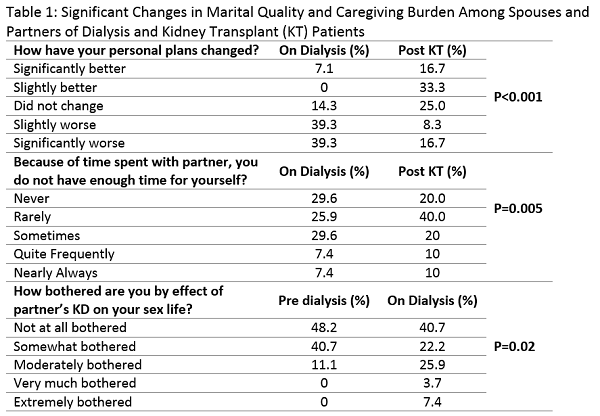Tangible Benefits in Caregiving Burden Among Spouses/Partners of Transplant Patients: Adding “Donor Benefit” to Live Donor Risk Assessment.
JHU, Baltimore
Meeting: 2017 American Transplant Congress
Abstract number: D247
Keywords: Donation, Kidney transplantation, Liver transplantation
Session Information
Session Name: Poster Session D: Living Donor Kidney Transplant II
Session Type: Poster Session
Date: Tuesday, May 2, 2017
Session Time: 6:00pm-7:00pm
 Presentation Time: 6:00pm-7:00pm
Presentation Time: 6:00pm-7:00pm
Location: Hall D1
Background The mental and physical health of spouses and co-habiting partners (dyads) are highly correlated. Dialysis entails significant caregiving burden and decreases the quality of life of dyads. Yet we use the same “risk tolerance” paradigm when evaluating spouses/partners for live donation, neglecting the benefit they might gain. In this study, we attempt to quantify this benefit by studying change in caregiving burden and quality of marriage when a partner waits on dialysis and then receives a kidney transplant (KT).
Methods We surveyed spouses and partners of KT patients (N=30) either at the time of transplant evaluation or 6 months to 3 years post-KT. Participants completed validated tools to assess current marital satisfaction (Satisfaction with Married Life Scale; Revised Dyadic Adjustment Scale), and caregiving burden (Zarit Caregiving Burden Score). Using revised items from these validated tools, participants also reported marital satisfaction and caregiving burden before their partners started dialysis; participants who were surveyed post-KT also reported these factors while their partner was on dialysis.
Results Participants reported being bothered by the effect of their partner's kidney disease on their sex life while their partner was on dialysis (p=0.02, Table 1). Participants also reported that they more frequently felt they did not have enough time for themselves while their partner was on dialysis as compared to after their partner's KT (p=0.005, Table 1). Participants reported improvements in their personal plans (e.g. traveling) after their partners received KT (p<0.001, Table 1). Overall marital satisfaction and caregiving burden scores were not significantly different at each time point. Conclusion Spouses/partners of kidney disease patients may experience negative changes in caregiving burden and marital quality while their partner is on dialysis, and improvements in caregiving burden and marital quality following their partner's KT. The tangible benefit that caregivers derive when their spouse/partner receives a KT should be considered when evaluating caregivers for live donation, particularly those with higher risk.
Conclusion Spouses/partners of kidney disease patients may experience negative changes in caregiving burden and marital quality while their partner is on dialysis, and improvements in caregiving burden and marital quality following their partner's KT. The tangible benefit that caregivers derive when their spouse/partner receives a KT should be considered when evaluating caregivers for live donation, particularly those with higher risk.
CITATION INFORMATION: Rasmussen S, Duquette L, Henderson M, Segev D. Tangible Benefits in Caregiving Burden Among Spouses/Partners of Transplant Patients: Adding “Donor Benefit” to Live Donor Risk Assessment. Am J Transplant. 2017;17 (suppl 3).
To cite this abstract in AMA style:
Rasmussen S, Duquette L, Henderson M, Segev D. Tangible Benefits in Caregiving Burden Among Spouses/Partners of Transplant Patients: Adding “Donor Benefit” to Live Donor Risk Assessment. [abstract]. Am J Transplant. 2017; 17 (suppl 3). https://atcmeetingabstracts.com/abstract/tangible-benefits-in-caregiving-burden-among-spousespartners-of-transplant-patients-adding-donor-benefit-to-live-donor-risk-assessment/. Accessed December 21, 2025.« Back to 2017 American Transplant Congress
